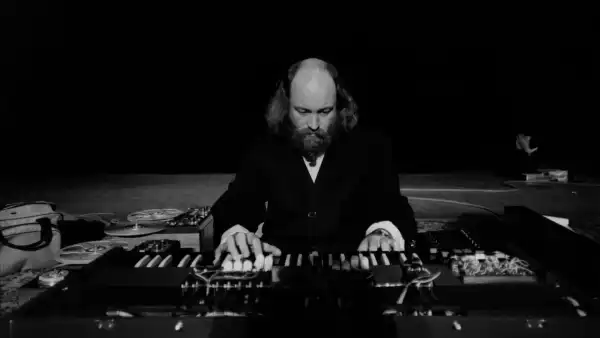
Save this storySave this storySave this storySave this story
“This Man Won’t Ruin Our Music,” proclaimed a poster in the underground newspaper the Berkeley Barb in November 1968. The accompanying illustration showed seven supposed radicals huddled in a jail cell. “The system is against experimentation,” the copy continued. “And the transcendental experiences that modern music offers.” The advertiser was Columbia Records, and, ironically, its attempt to monetize a youth movement was not by promoting the White Album or Electric Ladyland but experimental classical works—Charles Ives’s Concord Sonata, Karlheinz Stockhausen’s Mikrophonies, and the then-little-known Terry Riley’s In C. “They awaken the ear,” the ad raved. “And this man won’t stop you from diving in.”
The counterculture community rejected Columbia's artificial hype. Music columnist Ralph J. Gleason wrote in an angry article for the anarchist newspaper Fifth Estate: “The name of the game is to appropriate the rhetoric of revolution, as poverty programs have done, by exploiting the activists.” Radical publications discussed staging sit-ins at Columbia offices and “liberating” the label's vinyl records from stores. Following the backlash, the company stopped advertising in the underground press.
Fortunately, the controversy didn’t obscure the groundbreaking sound of Riley’s In C. Despite Columbia’s clumsy, condescending tagline—“The only legitimate trip you can take”—the album became a generation-defining crossover hit, marking the major-label entry into the pulsating musical revolution later called minimalism that was brewing in New York lofts and San Francisco studios. Upon its release, High Fidelity called In C “one of the defining masterpieces of the 20th century,” comparing its influence to The Rite of Spring. Glamour declared it “the first ritual symphony of the global village.” Now, for Riley’s 90th birthday, Sony Classical has reissued his four Columbia albums in a box set, including In C and the dazzling follow-up, A Rainbow in Curved Air. This release confirms Riley's seminal role in the musical history of the late 20th century and his unexpectedly broad cultural impact.
A native of Northern California with an aura of Zen calm, Riley was part of a generation of young American composers who turned away from the detached atonality promoted by their teachers at the postwar, science-minded academies. They turned instead to jazz, pop, and other cultural traditions—and, for Riley, to psychedelic experiences. While studying composition at Berkeley and working as a bar pianist in the late 1950s, he became close to La Monte Young, a radical wunderkind whose string trio stretched dodecaphony into a series of long, droning notes. The piece’s slow tempo, inspired by an Indian raga, prompted Riley to experiment with static and repetition.
Young soon moved to New York, where he made a name for himself performing in Yoko Ono’s loft, while Riley headed to Europe. Settling in Paris with his wife and daughter, he performed in a bar on the Rue Pigalle for prostitutes and drunken businessmen, and accompanied American military bases. When asked to write the music for an avant-garde play, he enlisted trumpeter Chet Baker, then bouncing around Europe between drug arrests, to record Miles Davis’s “So What” as the basis. Working with a French engineer, Riley began running Baker’s recording between tape machines, creating layers of sound—a technique that presaged today’s loop pedals and created a hazy reimagining of cool jazz.
When the Paris opportunities dried up, Riley returned to San Francisco to his old job playing piano in a bar. In the spring of 1964, riding the bus to work, he had an epiphany: adapting electronic loops for live performance via musical notation. “In C” is a sequence of fifty-three short riffs, designed to be repeated over and over again. The score fits on a single sheet of paper and can be performed by any number of musicians. The result is a slowly morphing kaleidoscope of consonant tones that, in its accessible conception and improvisatory nature, is a challenge to the fashionable atonal intellectuality. “I felt right about making ‘In C,’” Riley later said. “It was a statement, in harmony with my being, about what music could be.”
The premiere took place in the fall of that year at the San Francisco Recording Center, with composer Steve Reich participating. At a rehearsal, Reich suggested that the pianist play continuous eighth notes in C, uniting the musicians in a vigorous rhythm that would later permeate his own work and become a symbol of minimalism. The San Francisco Chronicle raved about the premiere, but the Columbia recording four years later cemented In C’s status as a manifesto of revolution in modern classical music. “‘In C’ embodied the spirit of the West Coast hippies, offering a new, gradual approach to form,” wrote composer John Adams in his memoirs. “It was a provocation, a Crumb-style gesture to the stuffy world of academic modernism.” The backlash was immediate: Riley’s alma mater allegedly banned the record from its faculty, and in Moscow, a modernist composer, having received a contraband copy of the score, flushed it down the toilet in protest.
Fate brought Riley back into the recording industry. After a San Francisco gig, eager to return to Europe, he followed the advice of a stoned hippie and drove the family Volkswagen to Mexico to catch a transatlantic liner. When the boat failed to arrive, the family ended up in New York City three months later, where Riley traded a bus for an apartment on Grand Street. He reunited with Young, playing in his iconic drone band, and, inspired by John Coltrane, mastered the soprano saxophone, performing all-night shows using the tape-delay technique from his Paris experiments. A young composer, David Berman, an editor at Columbia Records, visited one of Riley’s loft shows in 1967: “I was struck by the joyful tonality of his music—something unique,” he later recalled. (Berman, the son of New Yorker writer S.N. Berman and an electronic innovator himself, will be honored at an event in the Issue Project Room on October 8.) Berman persuaded Columbia Masterworks to launch a “Music of Our Time” series that bridged the avant-garde with the rock market.
For the Columbia recording of “In C,” Riley assembled eleven musicians, using three takes to create the effect of a large ensemble. There have been more than twenty versions of “In C” over the decades since—my favorite is the 2001 Bang on a Can All-Stars rendition—but the 1968 original retains its crystalline euphoria. The score was printed on the LP’s inner sleeve, allowing anyone to reproduce it at home. The best way to experience “In C” is to gather like-minded people for a live performance. As a saxophonist, I’ve played the piece many times since college, including a midnight set at a charity marathon. After an hour of ecstasy, the trombonist, playing a pulsating marimba, kept hitting the C note, unaware that the others had fallen silent.
There was a gulf between Columbia’s marketing slogan—“Let the magician Terry Riley take you on a tangerine carousel into a sunny universe of childhood dreams”—and the utopian spirit of the music itself, steeped in the artist’s life. But that tension was embodied in Riley’s second album for Columbia, 1969’s A Rainbow in Curved Air. The title track is a mesmerizing 18-minute improvisation for electric organ, with shimmering melodies rising and falling like an Indian raga. Riley was one of the first to use eight-track recording at Columbia, even waving his tambourine around the microphones during the sessions.
“A Rainbow in Curved Air” exudes joy, as does its cover: a smiling Riley against a backdrop of clouds over an idyllic landscape, like the patron saint of psychedelia. On the back is a poem he wrote, with the line, “They turned the Pentagon upside down and painted it purple and yellow and green.” The B-side, “Poppy Nogood and the Phantom Band,” creates a melancholy texture from swells of soprano sax and tape delays. It’s a virtuosic piece that might have remained niche, like much of Riley’s work, now prized rarities, if not for Columbia’s resources. The advertising campaign caught the attention of Pete Townshend, who was inspired by the synth riff for The Who’s “Baba O’Riley,” and Mike Oldfield, whose “Tubular Bells” (from The Devil’s Rejects soundtrack) is steeped in the Rainbow aesthetic.
The same week as the Rainbow sessions, Riley recorded a third album for Columbia with the Velvet Underground’s John Cale, an attempt to fuse rock and the avant-garde. Though the result was intense, the collaboration began to fray: The drummers kept time while Riley and Cale played complex patterns on different instruments; during the mix, Riley’s organ loops got lost in Cale’s guitar distortions. Riley had reached his limit and left for California. By the time Church of Anthrax came out in 1971, he was moving in a new direction: a student of Indian musician Pandit Pran Nath, along with Young, he devoted himself to the kirana. (The box set also includes “Shri Camel,” a hypnotic raga improvisation from 1980.)
In the 1970s, when Reich and Philip Glass were challenging the classical establishment, Riley remained a marginal figure. Critics defining minimalism mentioned “C major,” but rarely took his improvisational practice seriously. Asked if he considered himself a minimalist, Riley replied, “I felt like a transcendentalist, an illusionist. My field was to create magic in sound, to transcend the ordinary. Music as awakening.”
When the Kronos quartet approached Riley about writing a new piece for them in 1980, he hadn’t composed for a decade. Since then, the group has become his primary collaborator. Riley celebrated his 90th birthday in June with a supergroup performance of In C at New York’s Roulette; performances under flutist Claire Chase at the Ojai Festival featuring new works, including the haunting “The Holy Liftoff”; and a new arrangement of “A Rainbow in Curved Air” by his son Gian, which the Bang on a Can All-Stars will perform in Los Angeles on September 7. Riley participated remotely; since the pandemic began, he’s been living in Japan, continuing to compose, perform ragas, and teach.
As Riley approaches his age, other minimalist pioneers are concerned with legacy. Nonesuch has released a 27-disc box set of Reich. Glass has a cloth edition of his piano etudes, with tributes from Martin Scorsese and others. Even Young, notoriously sparse in his releases, has released a vinyl version of his early Trio for Strings for $196. Riley’s box set (CD and digital only) captures some of his legacy, but reflects a search for enlightenment amid the vagaries of the Woodstock-era industry.
In a 1975 DownBeat interview, Riley was asked about the pressure to make a follow-up to In C and his turn to Indian music. “People are afraid of cultural expansion, that artists will lose their authenticity,” he replied. “It has to do with the idea of scaling up — writing a second world symphony as a publicity strategy. Pran Nath’s teachings deepened my search. The goal is to increase impact, not make cosmetic changes.”
Sourse: newyorker.com






